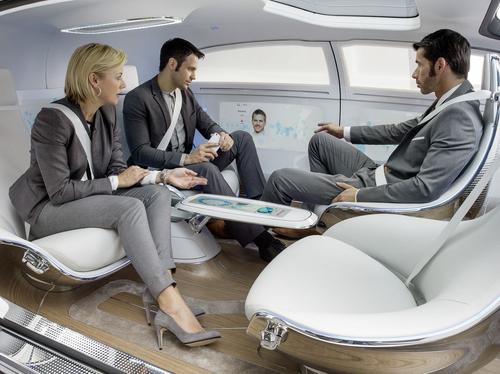August 7, 2015

Evolving automotive and transportation models have automakers and suppliers divining the future of in-vehicle environments and the suitable materials for interiors.
Among the areas under examination by one company, Yanfeng Automotive Interiors (YAI), the world’s largest supplier of interiors, are autonomous vehicles and shared mobility cars.
Autonomous vehicles could be commercial as soon as 2020, among premium models. There has been plenty of activity in the area: the Pentagon has tested autonomous military vehicles for years, Google continually experiments with an autonomous fleet on public roads, and the University of Michigan just opened a 32-acre facility called M City to test autonomous driving in urban conditions, just to name three.

Meanwhile, shared mobility car services, in which drivers rent vehicles using smartphone apps and retrieve them at public spaces, are a growing business. Examples include DriveNow, a joint venture between BMW and German rental agency Sixt; Car2Go from Daimler; and Zipcar.
YAI is huddling with global OEMs to sort out interior concepts for these markets, said Han Hendriks, vice president of product development and sales. YAI was formed July 2 as a joint venture between Yanfeng Automotive Trim Systems Co. Ltd. and Johnson Controls. Revenues this year for the venture are projected to be $8.5 billion, with an order backlog of $10 billion.
MORE FROM DESIGN NEWS: Advanced Metals Gaining Ground in Lightweight Vehicles
YAI is focusing on interior concepts for autonomous vehicles that will make generous use of polymer materials to optimize comfort, safety, and occupant productivity.
Hendriks offers insight as to what this might entail. Once a car is in autonomous mode, the steering wheel recedes into the instrument panel to create space for the driver, seats swivel so the driver and passengers face each other, and ambient lighting changes, possibly from blue to red to indicate autonomous operation. Tables emerge from a center console for work or other purposes, and the console’s controls allow for operation of electronic functions.
One likely feature, Hendriks said, is the use of “smart” surfaces throughout the cockpit. They could be part of a climate control system, used to display images and messages during a teleconference, or platforms for infotainment, GPS navigation, and other functions.

Functional and durable interiors will figure prominently in purpose-built shared mobility vehicles. Hendriks noted that because these cars will be used by hundreds of people during their service lifetimes and change hands without cleaning by attendants, cleanliness, sanitation, and damage will be concerns.
MORE FROM DESIGN NEWS: What Can Be Done About Car Hacking, or Is This the Future of Autos?
YAI is discussing concepts with OEMs that include techniques for disinfection and maintaining clean interiors through the use of antimicrobial plastics with inherent protection or special coatings, self-healing polymer surfaces that repair minor scratches and dents, and air purification so renters are not exposed to lingering odors.
Some of these concepts will be on display at the Frankfurt International Motor Show in Germany, Sept. 15-27, when YAI displays its ID16 concept interior, an annual look at design ideas.

We’re heading to Philly! Design & Manufacturing Philadelphia will take place Oct. 7-8. Get up close with the latest design and manufacturing technologies, meet qualified suppliers for your applications, and expand your network. Learn from experts at educational conferences and specialty events. Register today and join us at Philadelphia’s premier industry showcase!
Pat Toensmeier has more than 30 years of experience writing for business-to-business publications. His main areas of coverage have been defense, design, manufacturing, technology and chemicals, especially plastics and composites. He has reported extensively on developments in these areas from the U.S. and Europe, and covered industry events as well in Brazil and Asia. Toensmeier has held various positions at major publishers such as the McGraw-Hill Companies and Hearst Corporation. A graduate of the University of Missouri, he is a contributing editor for several print and online publications. Toensmeier is based in suburban New Haven, Conn.
About the Author(s)
You May Also Like





